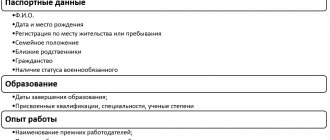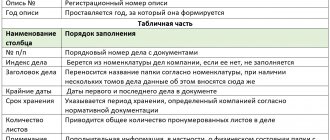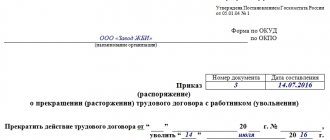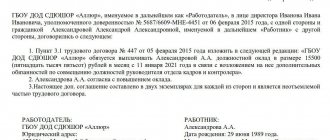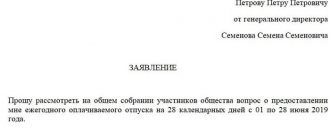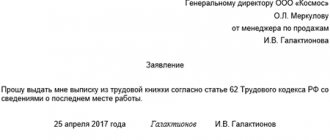What documents are included in a personal file?
It is recommended to place documents in your personal file in the following sequence:
- An inventory of the composition of the personal file, the sequence of all documents for easy searching.
- Application for a job.
- Employee profile with photos.
- Employment contract.
- A copy of the employment order.
- A copy of the certificate and diploma of education.
- Documents from the military unit, as well as confirming the absence of a criminal record.
- Registration at the place of residence.
- Characteristics from previous places of work, letters of recommendation.
An inventory of an employee’s personal file consists of a title, document number and index, inclusion date, sheet number and note. The note usually indicates which document is used - a copy or an original.
Personal matter concept
It is a file of documents grouped for each employee and stapled into a single folder with an inventory.
Formation of personal files is mandatory only for state bodies and municipal authorities. Their compilation and maintenance at other enterprises is at the discretion of the company administration.
This responsibility is assigned to the personnel department, which begins the employee’s personal file at the time of his hiring and closes it upon dismissal. It includes the employee’s personal data, documents prepared at the enterprise itself, etc.
The main regulatory rules are GOST 51141-98 and 17914-72, as well as federal laws on public service. But their requirements are mandatory for establishments and institutions. Other companies can use them in their work, or carry out registration of personal files using their own methods.
However, all enterprises are subject to the provisions of the Personal Data Law, according to which the employer is recognized as the data processor, and therefore he must ensure the protection of the personal information of his employees and prevent its disclosure.
Therefore, personal files should be stored in places where access to unauthorized employees of the enterprise is limited.
And requests for information contained in a personal file must be controlled and recorded in special registers. Unauthorized disclosure of personal information entails bringing the company to administrative liability. Important! Before collecting personal information from an employee, you must first sign a statement with him that he gives his consent to the processing of personal data.
How is it carried out?
All personal files of the enterprise are displayed in a special notebook or journal, where they are provided with a special number at the place of work. This journal contains brief information about the case: Full name. employee, date of transfer to the archive, start date of the case, number.
It is a mistaken belief that any HR department employee has access to employees’ personal files. This is not true, all power and ability to make changes is exercised by the authorized person. Changes may be the following: documents from the registry office, name change and others. In this case, copies of documents confirming the facts are entered into the personal file.
Proper storage of personal files is very important, because this is confidential information to which a limited number of people have access.
Storage periods for personal files:
- personal files of employees are kept for up to 75 days;
- personal files of senior positions can be stored for an unlimited amount of time;
The retention period begins from the moment the file is transferred to the archive.
Registration and maintenance of personal files
[ads-pc-2] [ads-mob-2]
The folder for the employee is opened at the time of his appointment. The first to be tampered with is the personal card issued to the employee, which contains, in addition to basic information about him, a photograph of the employee. Next, all copies of documents submitted by the employee are filed. This also includes the forms he fills out when registering.
Throughout the entire activity at the enterprise, responsible officials include in chronological order the documentation related to him, for example, various statements, reports, explanatory notes. Orders issued at an enterprise regarding personnel in relation to an employee do not need to be sewn into the folder with his file if they are recorded in a personal card. You can file extracts from these documents into your file.
All sheets of the personal file must have continuous numbering.
Upon termination of the employment contract, the folder with all documents is closed. Before transferring it to the archive, it is advisable to make an inventory of your personal file, if it was not completed from the very beginning. It is a named list of all documents contained in it with page numbers. This can be a template developed by the organization, where only pages fit, or a list filled out by hand or using a computer.
When closing, the date of completion of the personal file is marked on the front folder, and an index is assigned in accordance with the existing nomenclature of files.
In accordance with the law, the storage period for personal files is 75 years.
Registration procedure
Since in any enterprise, due to the large number of employees, it is impossible to keep track of all documents and their flow, it is very important to follow all the rules of registration in order to avoid the loss of important information that may interfere with the organization of the work process.
Proper storage and registration of personal files of all employees greatly simplifies the task:
- For example, if the company is large enough and employs a large number of employees, their personal files should be placed in alphabetical order. This will make it easier to find the desired folder.
- The employee’s personal file should not contain more than 250 pages.
- The cover page should display only basic information about the personal file. This is your full name. employee and case number at the enterprise.
Personal files can be stored in the following ways:
- In alphabet order.
- By structural divisions of the company (departments).
- Numbering of cases by their numbers or assignment of numbers during registration.
Why do you need an inventory?
This simple paper allows you to immediately record all the documents provided by the employee upon employment. Subsequently, it records all newly received papers in the personal file, the facts of seizure of documents for any needs and their return.
The blame for the loss or damage of the papers contained in the inventory is shifted to the shoulders of the employee responsible for storing personal files, which is a good reason to approach the preparation of the inventory very carefully, taking into account the fact that in practice there have been precedents for going to court regarding documents lost by the company.
Sample
As stated above, only authorized employees have access to make changes to personal files.
The heading for the personal file is your full name. employee. Variations in the spelling of the surname or the woman's maiden name may also be indicated. For example: Bread (Kalinina) Elena Maksimovna.
When registering a personal file, it is allowed to accept documents that are dated earlier than the date the employee was hired. This issue is considered in individual cases, but, as a rule, it is resolved in favor of the employee.
The complete case form includes the following items:
- Design and entry of data on the cover of the folder (cover design will be discussed later).
- It is important to record the number of sheets in the case (no more than 250 pages).
- Preparation of the certification sheet.
- Internal inventory of documents in accordance with the apparent quantity collected, data verification.
- File filing, case binding.
- Entering the necessary information into the cover of the employee’s personal file.
It is very important to know which documents are filed and which are not. The case file includes only the most important and significant documents, which can be stored for up to 75 years. If there are documents about the beginning of vacation, applications for vacation at your own expense, and the like, then these documents are not included in the filing folder. They are added to the total quantity.
Internal inventory of employee personal file documents: sample
Copyright: Lori's photo bank An inventory is a list of documentation that is collected in a common file, or a list of cases that are united by a common feature (an inventory of cases with statements, an inventory of personnel files, etc.).
This is a folder in which all documents relating to his work at this enterprise are filed. The registration of an employee’s personal file, its sample, is not regulated by any normative act common to all employers.
This type of inventory is usually completed when files are sent for storage to the archives. A personal file is a collection of all documentation relating to a particular person.
As a rule, these papers are stapled into a separate file or collected in a folder. The list of securities included in it is not regulated (with the exception of government agencies), so the company has the right to independently determine and establish it. Also, the list of documents depends on the specifics of the work or category of the employee.
The personal file consists of the following papers, originals or copies:
Instructions for filling
After establishing an employee’s personal file, he must fill out a form. The questionnaire must provide comprehensive answers to all questions.
Laconic and clear answers without unnecessary fluff. After the questionnaire, you should place a photo of the employee. This should be a new photo, and not one where he is 18, when in fact a man of about 40 is standing in front of you. The autobiography must be compiled correctly and reflect all stages of the employee’s life. Educational institutions, interests, places of work and more.
Copies of documents on education or advanced training in certain areas must be certified first. When compiling a personal file, an employee is obliged to promptly report any changes (last name, first name, etc.).
The external characteristics of the employee are signed by the director of the enterprise, and the internal characteristics - by the head of the division or department of the company. All pages must be numbered.
Normative base
First of all, a local regulatory act (regulations or instructions for maintaining personal records) should be developed, which prescribes the rules and requirements for the design, content, maintenance, storage of personal files, etc.
When compiling an employee’s personal file, the requirements for its registration are regulated by the following regulations:
- Labor Code of the Russian Federation (Chapter 14).
- Federal Law of July 27, 2006 No. 152 “On Personal Data”.
- Federal Law of October 22, 2004 No. 125 “On archiving in the Russian Federation.”
- “Basic rules for the work of archives of organizations”, approved by the decision of the Board of Rosarkhiv dated 02/06/2002.
- GOST R 6.30-2003, adopted by Decree of the State Standard of the Russian Federation dated 03.03.2003 No. 65-st (from 01.07.2018 ceases to be valid due to the introduction of the National Standard of the Russian Federation GOST R 7.0.97-2016, approved by Order of Rosstandart dated 25.05.2017 No. 435 -st).
- Order of the Ministry of Culture of the Russian Federation dated August 25, 2010 No. 558 “On approval of the List of standard management archival documents generated in the course of the activities of state bodies, local governments and organizations, indicating storage periods.”
You can also refer to the regulatory documents regulating personnel work in this area in government agencies, which can help in the development of LNA:
- Federal Law No. 79 dated July 27, 2004;
- Federal Law of March 2, 2007 No. 25;
- Decree of the President of the Russian Federation dated June 1, 1998 No. 640;
- Decree of the President of the Russian Federation dated May 30, 2005 No. 609.
Sample title page design
GOST 17914-72 dated July 17, 1972 regulates the rules for registering personal files, they are as follows:
- At the top of the title page there may be information that is allowed to be filled out only by the municipal or state archive, these are codes, dates of submission of documents to the archive, and more.
- In the center of the title page, slightly indented from the top, you must indicate the name of the organization. As a rule, the abbreviated name of the company is written in this place.
- Below the name of the company, the department in which the new employee works is indicated.
- Then the case number is indicated, which is taken in brackets. It must be preceded by an index, also in parentheses.
- Then the title of the personal file is written. The last name, first name, and patronymic of the employee are used as the heading.
- The lower right corner of the title page is intended for information such as the date of hiring the employee, the day of dismissal, the storage period of documentation, the date of filing in the archive, and more.
Basic requirements of the law
For a state enterprise, the employee’s personal files are mandatory, as specified in Part 3 of Art. 42 No. 79-FZ “On the State Civil Service of the Russian Federation” dated July 27, 2004. Therefore, on the day of hiring, a personal file is opened for each civil servant and entered into the database.
When changing jobs, the new employer will easily receive all the necessary information about the employee.
Thus, a single database facilitates access to complete information about payment data and the formation of tax payments, labor and general length of service, age and other necessary information of employees.
The situation is somewhat different when taking into account employees in a private enterprise. No law or act of labor legislation obliges a manager to open personal files for his employees.
Constant staff turnover or lack of time and funds complicates the process, leading many to consider it unproductive. On the other hand, no one prohibits the establishment of such an accounting system in an organization.
To do this, you need to issue a specific act, order or instruction, which will fully and clearly disclose all the rules for the preparation, maintenance and storage of documents. It is imperative to indicate the official who will be responsible for maintaining and processing, as well as storing the personal files of employees.
How much to store and where
In the HR department, employee files are kept throughout the entire period of their work in the organization. For these purposes, a special place is equipped to prevent access to them by third parties, as well as the possibility of their theft or loss. Typically these are locked safes or metal cabinets or rooms.
When an employee resigns, the personal file is closed. The case is closed - this means that it is completely processed and completed. In this case, first, an internal inventory is filed with a final record of the number of sheets and documents in it, and at the end - a certification sheet. The title page indicates the date of closure of the case (date of dismissal) and the period of its storage, which begins to be calculated from January 1 of the year following the year of closure.
The personal files of those dismissed are kept in the organization for three years, then are handed over to the archives. If the file was created after 2003, then its storage period is 50 years, if earlier - then 75 years (Article 22.1 of the Federal Law of October 22, 2004 No. 125). If your personal file contains documents with different maximum storage periods, then the entire file is stored according to the older period.
source: gosuchetnik.ru
“Personnel officer. Personnel records management", 2011, N 11
RULES FOR THE FORMATION AND REGISTRATION OF AN EMPLOYEE’S PERSONAL FIELD
A HR employee needs to have accurate, complete, objective information about the organization’s employees. Data related to the work activity of each employee is collected in a kind of dossier - a personal file. Whether it is necessary to maintain personal files and what documents can be stored in personal files is discussed in this article.
General rules for systematizing documents and creating files
Dictionary of personnel records management. A case is a collection of documents or a document related to one issue or area of activity, placed in a separate cover. Cases are considered initiated from the moment the first executed document is included in them.
Formation of a case - grouping executed documents into a case in accordance with the nomenclature of cases and systematization of documents within the case (GOST R 51141-98).
A moving case is a case whose documents reflect the resolution of an issue lasting more than one year (company charter, personal file, criminal case, etc.).
In order to quickly search for documents, as well as to ensure their safety, systematization and formation (grouping) of documents into files is necessary.
The rules for grouping various types of documents and their further formation into files are set out in the Basic Rules for the Operation of Archives of Organizations [1]. The principle of forming cases is based on the retention period of documents. The storage periods for documents are established by the Federal Archive Service and apply to all organizations regardless of their form of ownership. The storage periods for documents are indicated in:
— List of standard archival documents generated in the scientific, technical and production activities of organizations, indicating storage periods (approved by Order of the Ministry of Culture of Russia dated July 31, 2007 N 1182);
— A list of standard management archival documents generated in the course of the activities of state bodies, local governments and organizations, indicating storage periods (approved by Order of the Ministry of Culture of Russia dated August 25, 2010 N 558).
It should be noted that there are serious doubts about the latter document. The decision of the Supreme Arbitration Court of the Russian Federation dated 09/06/2011 N 7889/11 “On the refusal to satisfy the application for recognition as partially invalid Order of the Ministry of Culture of the Russian Federation dated 08/25/2010 N 558” says that this Order of the Ministry of Culture of Russia, which approved the List and storage periods of archival documents of public and private organizations , was declared not to have entered into force, since it was not officially published in full. On this basis, the Supreme Arbitration Court of the Russian Federation refused to recognize it as inconsistent with the law and ineffective. The applicant (OJSC MMC Norilsk Nickel) demanded that this Order be declared illegal on its merits, since, in his opinion, it does not comply with the Federal Law “On Archival Affairs in the Russian Federation”, was adopted in violation of the powers of the Ministry of Culture of the Russian Federation and violates the rights and the legitimate interests of the applicant in the area of his business activities, illegally imposing on him the obligation to store and provide shareholders at their request with an unreasonably wide range of documents.
This Decision of the Supreme Arbitration Court of the Russian Federation may be reviewed in the manner of supervision within a period not exceeding 3 months from the date of its entry into legal force.
Documents, in accordance with their historical, economic, cultural and other value, have the following storage periods:
— temporary storage (up to 10 years inclusive);
— long-term shelf life (over 10 years);
- permanent shelf life.
State archives receive only documents with a permanent storage period; documents up to 10 years of storage remain in the organization or enter the departmental archive of the organization (archive of the organization).
The main requirement for the formation of files is the grouping of permanent and temporary storage documents into separate files.
Only in exceptional cases, documents of different retention periods, but related to the consideration of one issue, are placed in one folder, but after a decision is made and the case is completed, the documents are reformatted.
Documents are compiled into a case within 1 calendar year. The exception to this rule is moving cases.
The moving case is included in the list of cases for the next year with the same index.
The documents are placed in the file with all related attachments and additional materials that arose in the course of resolving the issue. In cases where applications are large, they can be formed into separate volumes. Documents are included in the file only in one copy, so drafts and duplicate copies are not filed in the file.
The thickness of each case should not exceed 30 - 40 mm, this is about 250 - 300 sheets. If there are more documents, the case is divided into two or more volumes.
Features of creating an employee’s personal file
Dictionary of personnel records management. A personal file is a systematized set of personal and primary accounting documents characterizing the employee’s work activity.
An internal inventory of a case is a document containing a list of documents included in the case, and is intended to record documents of certain categories of permanent and temporary (over 10 years) storage periods, the recording of which is caused by the specifics of this documentation (especially valuable, personal files, etc. .).
It is necessary to be especially careful when creating an employee’s personal file, since the storage period for this file is 75 years and the documents in this case serve as confirmation of the entries in the employee’s work book.
Article 42 of the Federal Law of July 27, 2004 N 79-FZ “On the State Civil Service of the Russian Federation” (as amended on July 11, 2011) obliges the personnel service to reflect the entire period of civil service of an official in his personal file, but in other organizations maintaining a personal file is not necessary . However, in accordance with Part 1 of Art. 17 of the Federal Law of October 22, 2004 N 125-FZ “On Archival Affairs in the Russian Federation” (as amended on July 27, 2010), documents on personnel are especially highlighted among those archival documents whose safety is required to be ensured by state bodies, local governments, organizations and citizens engaged in entrepreneurial activities without forming a legal entity.
The composition of personal file documents is not fixed by law.
Personal files are opened for managers of all ranks, specialists, employees who have material or information resources, who own valuable or confidential information, documents, and databases. Personal files are usually not opened for workers (including temporary workers) and technical staff of organizations. All necessary information about them is reflected in the personal registration card of form N T-2 or N T-2GS.
Composition of employee personal file documents
A personal file is opened after the issuance of an order to hire an employee.
A personal file is formed in two stages:
— in the process of hiring an employee for a position after signing an employment contract and issuing an order for employment;
— in the process of maintaining a personal file during the employee’s working life.
At the first stage, the documents in the personal file are arranged in the following sequence:
— internal inventory of case documents;
— copies of diplomas of education and the award of academic degrees, certificates of conferring academic and honorary titles, award documents, various certificates and other documents confirming certain personal data;
- a copy of the employment order.
Drawing up an autobiography, resume and application, as well as the procedure for entering them into the employee’s personal file, is not mandatory and depends on the accepted hiring procedure in a particular organization.
When creating a personal file, it should be taken into account that, in accordance with the Labor Code of the Russian Federation, an application for employment is not the basis for hiring an employee (the basis is an employment contract), that is, it is not necessary, and autobiographical information is duplicated in the personal card, as well as summary.
At the second stage, documents are located in personal files as they are received.
An internal inventory is compiled to record documents of certain categories of permanent and temporary (over 10 years) storage periods, the recording of which is caused by the specifics of this documentation (especially valuable, personal files, etc.).
The specificity of compiling an internal inventory of documents in a personal file is that it is included in the file immediately upon its establishment and is filled out as it is maintained. That is why the internal inventory provides for the inclusion of new documents in the personal file, as well as the removal of documents from the personal file, and the replacement of originals with copies (recorded in the “Note” column).
If the case is already bound and filed, then the internal inventory of the documents of the case, certified by the compiler, is pasted at the top edge to the inside of the front cover of the case.
It should also be noted that when preparing a file for submission to the archive, the internal inventory sheets are numbered separately from the personal file sheets.
Copies of educational documents must be certified by a HR employee. A mark on the certification of the copy is affixed with a special stamp or done by hand. The copy certification mark includes the following elements.
A copy of the employment order must also have a mark on the certification of the copy, drawn up according to the sample specified above. Otherwise, it will be a photocopy or a copy that has no legal force.
You should not write “Copy is correct”, since it is already clear that this is a copy and not the original. When a copy is issued outside the organization (and personal records will be transferred to the archive), a stamp is affixed to it.
source: hr-portal.ru
